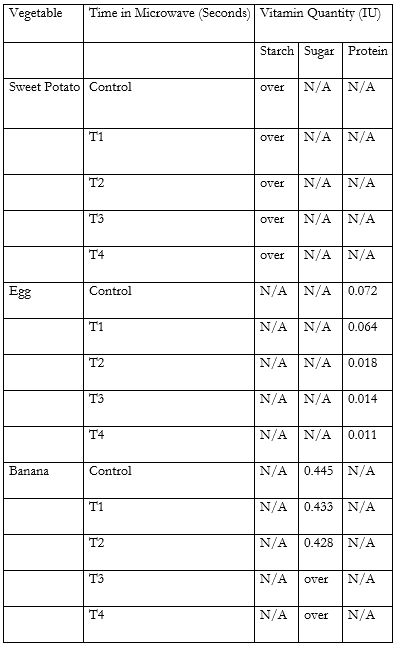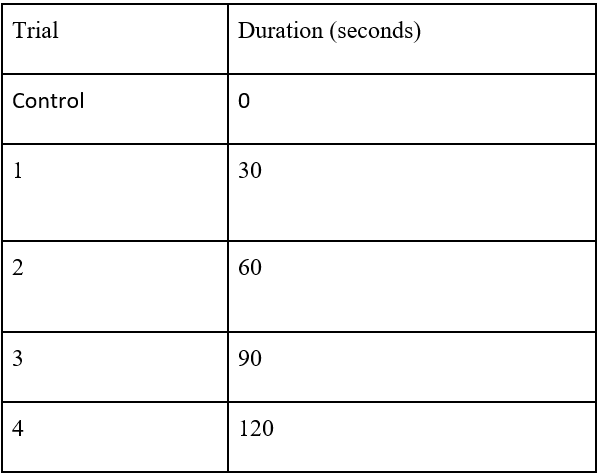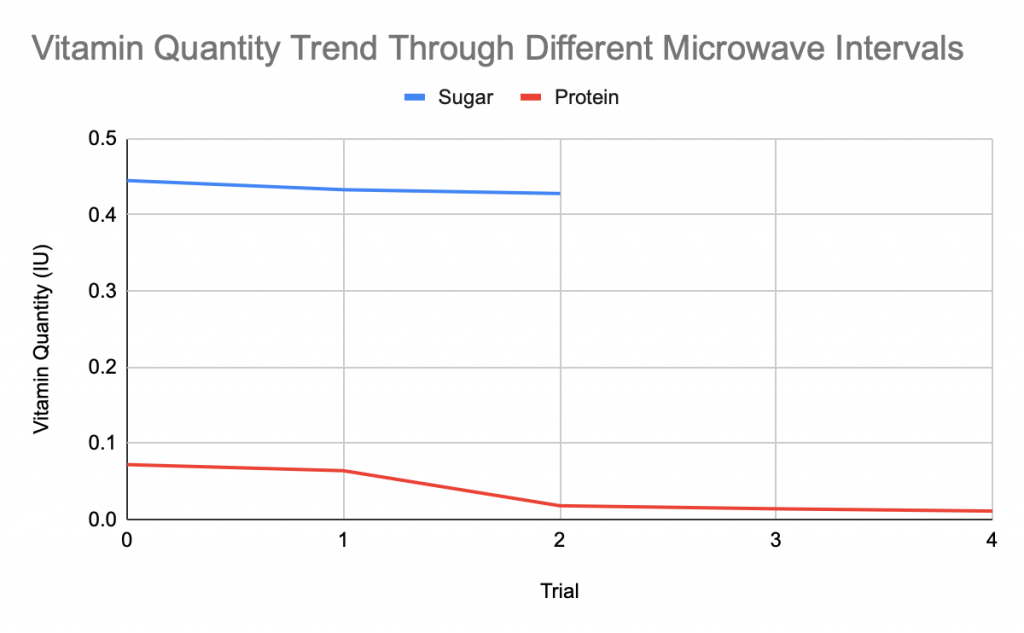Anthony Dinglasan, Year 2 Research
Abstract
This project determined whether microwaving sweet potatoes, bananas, and eggs will affect the nutritional quality of food. To accomplish this, the experiment tested for the starch, sugar/glucose, and protein qualities of different foods before and after several microwave heat intervals. Several solutions including iodine, benedict, and biuret solutions were used to assess the nutritional value of each sample. A spectrophotometer was also used to quantify the results and to determine trends. It was found that the nutritional value of the food decreased slightly for every 30 second interval of using the microwave but not severe enough to cause any health concerns. The results of this experiment have implications for optimizing healthy food preparation.
Introduction
The first microwave was built in 1946 and since then, it has become a worldwide staple of innovation (Osepchuk 2009). Since 1998, an estimated 88% of Canadian households have reported using a microwave daily (Regier et al. 399). Microwave heatwaves are produced through an electron tube termed the magnetron (Osepchuk 2010). The microwaves are then reflected within the metal interior of the oven and absorbed by the food, increasing the temperature of the subsistence within (Mahdi et al. 2018). While microwaves are hailed for being fast and efficient, they are still being met with scepticism (Hoogenboom et al. 2009).
Extensive research has been done to determine whether microwaves have an influence on the nutritional value of food. On one hand, microwaves have proven to significantly reduce several vitamins such as superoxide dismutase, catalase activities, and vitamins A and E in experiments conducted on rats (Eke et al. 2017). However, microwaving food has also been linked to having the least impact on vitamins/minerals than almost any other cooking method, suggesting microwaving food may indeed be a healthy method to cook food quickly (Alajaji and El-Adawy 2006). Due to the ongoing debate, this experiment attempted to assess whether the nutritional value of food (measured in international units [IU]) was affected by using a microwave. Three foods were chosen for testing: banana due to its high sugar content, sweet potato due to its high starch content, and egg due to its high protein content (Debabandya, et al. 2010, Zhu et al. 2014, and Y. Mine 2007).
Materials and Methods
After warming up the spectrophotometer for 15 minutes, it was set to 430nm. Distilled water was added to a clean cuvette, representing the blank for the experiment. The blank was inserted into the spectrophotometer. An egg was cracked, and the egg whites were filtered into the bowl using a thin funnel. 30 ml of distilled water was added to the bowl immediately after. Using a pipette, 4 ml of Biuret solution were inserted into the test tube, shaken, and allowed to stand for 5 minutes. A sample of the egg white biuret solution was poured into a cuvette. The test tube was microwaved for 30 seconds. A sample of the biuret solution was placed into a cuvette. Two more samples were completed, and each sample was heated by a microwave in 30 second increments. After assembling 4 cuvettes of biuret samples, the controlled sample cuvette (the cuvette with no microwave heating) was placed into the spectrophotometer. The value was recorded and the process of using the spectrophotometer was repeated for the remaining four samples. To test the protein samples with the biuret test, the above steps were repeated except with 5 grams of grounded sweet potato diluted with 30ml of distilled water.
After all starch samples were complete, the blank was re-inserted into the spectrophotometer. A water bath was pre heated to 90 degrees Celsius. Five grams of banana were ground, 30 ml of distilled water was added to it, and the solution was mixed for 2 minutes. The banana mixture was poured into a test tube. Using the pipette, 4 ml of benedict solution consisting of 20 insertions of 200 microlitres was added to the test tube and shaken. Once the water bath was at 90 degrees Celsius, the test tube rack was placed into the water bath for 5 minutes. The spectrophotometer procedure was repeated as outlined above.
For the biuret solution results, if the finished solution is purple or blue, then proteins are present. Similarly, in Benedict’s solution results, if the finished solution is red-brown, then reducing sugars (glucose) are present. For the Iodine solution results, if the finished solution is blue-black, then starch is present. If the finished solution displays no shades or colours, then the vitamin is absent from the sample.
Results
Table 1: Vitamin Quantity in Several Samples of Food

Table 2: Microwave intervals


Figure 1: Vitamin Quantities through different microwave intervals
Upon testing the starch in sweet potatoes over several microwave increments, the highest level of starch was found from the sample that had no microwave radiation influence. Although no numerical values could be derived, the starch sample colours changed in a gradient fashion. In the controlled cuvette, the colour resonated a dark blue (almost black shade). After 30 seconds of microwave radiation heat, the second sweet potato sample cuvette remained a dark blue. After 60 seconds in the microwave, the third cuvette changed to a lighter shade of blue. After 90 seconds in the microwave, the fourth cuvette remained in the same shade of dark blue as the third trial. Finally, after 120 seconds, the fifth cuvette shade of blue became pale; with a light blue colour code of #8AC7DB.
For sugar trials, the control cuvette sample had a higher sugar quantity than the third sample which underwent 60 seconds of microwave radiation. In the protein trials, the control cuvette had the greatest protein quantity as predicted and through 30 second microwave increments, the quantity of protein diminished as shown by the smaller numerical values.
Discussion
This experiment was done to test the nutritional quantity of several foods over time as they were being microwaved. The results from this study provided a supporting correlation that microwaving food does have a negative effect on the nutritional quality (Han et al. 2021). The declining numerical values signifies the diminishing intensity of the colour indicator. Ultimately, this represents the shrinking nutrients present in the samples as they continue to be microwaved. In all three cases of sugar, starch, and protein, all controlled cuvettes had a greater quantity of the respective nutritional values than after the same sample was heated by a microwave for 120 seconds. It is deduced that there are some minimal differences in nutritional quality between foods that are heated by microwaves and those that are not (Khatoon et al. 2006, Cross et al. 2009). However, these differences are so miniscule that there are no harmful repercussions in using a microwave regularly (Lenaerts et al. 2018).
However, there are some limitations to this study. The strength of the nutritional quantity correlates to the shade of the colour. The iodine cuvette samples contained several small impurities which did not allow the spectrophotometer to provide proper numerical results. Upon testing the sugar qualities of banana, the fourth and fifth cuvettes also had some impurities within the samples, thereby prohibiting the spectrophotometer from providing numerical values. Secondly, the nutrient values may have been affected by the heat and not the microwave radiation. It should be noted that regardless of what cooking method is being used, nutrients will be lost, especially water-soluble vitamins such as Vitamin C and B (Ramalakshmi et al. 2021). This means that the electromagnetic radiation itself may not have been the cause for the small nutrient depletion but the heat.
Future studies should test whether it is the electromagnetic radiation or the heat that is diminishing these nutrients slightly. In addition, an improved experiment should also factor in how much water is inside the foods tested as water-soluble nutrients may leak out of the food as it is being absorbed by microwaves (Ritter 2019). As the microwave continues to be a popular appliance, users should be comforted that the electromagnetic radiation from the microwave will not damage the food being eaten.
References
Alajaji, S. A., & El-Adawy, T. A. (2006). Nutritional composition of chickpea (Cicer arietinum L.) as affected by microwave cooking and other traditional cooking methods. Journal of Food Composition and Analysis, 19(8), 806–812. https://doi.org/10.1016/j.jfca.2006.03.015
Bajkacz, Sylwia, and Elżbieta Kycia-Słocka. “Liquid Chromatography in Food Analysis.” Chemical Analysis of Food (Second Edition), Academic Press, 26 June 2020, https://www.sciencedirect.com/science/article/pii/B9780128132661000085.
Gwendolyn A. Cross, Daniel Y. C. Fung & Robert V. Decareau (2009) The effect of microwaves on nutrient value of foods, C R C Critical Reviews in Food Science and Nutrition, 16:4, 355-381,DOI: 10.1080/10408398209527340
Benedict C. Eke, Norbert N. Jibiri, Evelyn N. Bede, Bede C. Anusionwu, Chikwendu E. Orji, Chinwe S. Alisi, Effect of ingestion of microwaved foods on serum anti-oxidant enzymes and vitamins of albino rats, Journal of Radiation Research and Applied Sciences, Volume 10, Issue 2, 2017, Pages 148-151, ISSN 1687-8507, https://doi.org/10.1016/j.jrras.2017.03.001.
Han, Z., Cai, M.-jie, Cheng, J.-H., & Sun, D.-W. (2018, March 1). Effects of electric fields and electromagnetic wave on food protein structure and functionality: A Review. Trends in Food Science & Technology. Retrieved April 10, 2022, from https://www.sciencedirect.com/science/article/pii/S0924224417307033?casa_token=pasOyu153-EAAAAA%3A7tv2PUX7_rPskhzR36SZC85B9WVyqBm662RQelMuralNOAul8KmuuAzL4HZBYQQyaFDOHE3SQA
Microwave cooking and nutrition. Harvard Health. (2021, August 17). Retrieved March 26, 2022, from https://www.health.harvard.edu/staying-healthy/microwave-cooking-and-nutrition
Hoogenboom, R., Wilms, T. F. A., Erdmenger, T., & Schubert, U. S. (2009, March 20). Microwave-Assisted Chemistry: A closer look at heating efficiency. CSIRO PUBLISHING. Retrieved April 10, 2022, from https://www.publish.csiro.au/CH/CH08503
Houpikian P and Raoult D (2002) Traditional and Molecular Techniques for the Study of Emerging Bacterial Diseases: One Laboratory’s Perspective. Emerg Infect Dis. 8(2): 122–31. doi: 10.3201/eid0802.010141.
Järvinen A-K, Laakso S, Piiparinen P, Aittakorpi A, Lindfors M, Huopaniemi L, et al. (2009) Rapid identification of bacterial pathogens using a PCR- and microarray-based assay. BMC Microbiol. 9:161. doi: 10.1186/1471-2180-9-161.
Khot Prasanna D and Fredricks DN (2009) PCR-based diagnosis of human fungal infections. Expert Rev Anti Infect Ther. 7(10):1201–21. doi: 10.1586/eri.09.104.d
Lenaerts, S., Borght, M. V. D., Callens, A., & Campenhout, L. V. (2018, February 16). Suitability of microwave drying for mealworms (Tenebrio Molitor) as alternative to freeze drying: Impact on nutritional quality and colour. Food Chemistry. Retrieved April 10, 2022, from https://www.sciencedirect.com/science/article/pii/S0308814618302310?casa_token=d5Q_nf0UIN0AAAAA%3A2jp0TEyPErBXcFnl0bBgKfGjz7gLagsjTbVAn-wOk8w7wKAnM7F0azQpj-_E6wWdIWS6L0PItQ
Mine, Y. (2002). Recent advances in egg protein functionality in the food system. World’s Poultry Science Journal, 58(1), 31-39. doi:10.1079/WPS20020005 from https://www.cambridge.org/core/journals/world-s-poultry-science-journal/article/abs/recent-advances-in-egg-protein-functionality-in-the-food-system/0D926CA64E9C317B0BBC3EEBFA9A8456
“Liquid Chromatography-Mass Spectrometry in Food Analysis.” New Food Magazine, 20 Apr. 2017, https://www.newfoodmagazine.com/article/1274/liquid-chromatography-mass-spectrometry-in-food-analysis/.
Núñez O, Lucci P. Application of Liquid Chromatography in Food Analysis. Foods. 2020; 9(9):1277.https://doi.org/10.3390/foods9091277
Regier, M., Knoerzer, K., & Schubert, H. (2017). The microwave processing of foods. Google Books. Retrieved April 10, 2022, from https://books.google.ca/books?id=R4V4CgAAQBAJ&pg=PA399&lpg=PA399&dq=88%25%2Bof%2Bcanadians%2Buse%2Bmicrowave&source=bl&ots=pwxNQeh0bs&sig=ACfU3U1wncoZdKnDGSiQIa9YLSbSZfBysg&hl=en&sa=X&ved=2ahUKEwik8_PnyYr3AhWDKzQIHZ3IAL0Q6AF6BAgqEAM#v=onepage&q=88%25%20of%20canadians%20use%20microwave&f=false
Vallejo, F, et al. “Phenolic Compound Contents in Edible Parts of Broccoli Inflorescences after Domestic Cooking.” Wiley Online Library, John Wiley & Sons, Ltd, 15 Oct. 2003, https://onlinelibrary.wiley.com/doi/abs/10.1002/jsfa.1585
Vinskofski, Susan, et al. “Refractometer: A Simple Way to Test Produce for Nutrient Density.” Learning and Yearning, 21 Oct. 2018, https://learningandyearning.com/test-produce-for-nutrient-density.